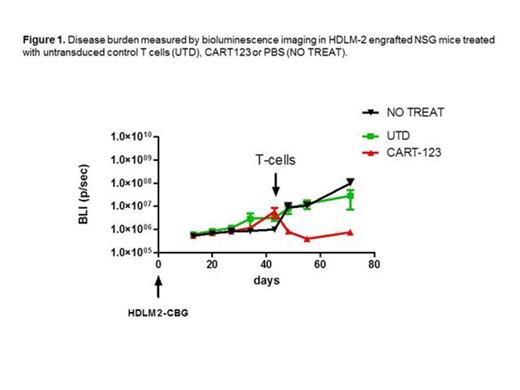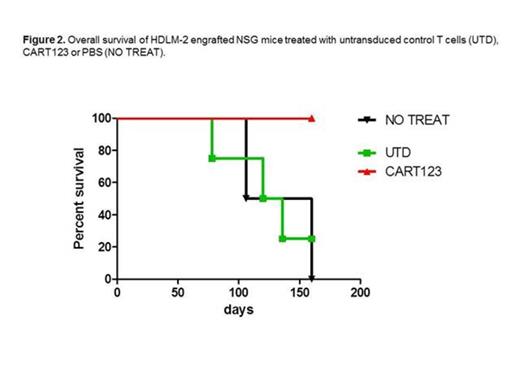Abstract
Hodgkin lymphoma (HL) generally carries a good prognosis. However, 10-15% of patients relapse or are refractory to first-line therapy. These patients have a poor prognosis and would benefit from innovative approaches. Our group and others have demonstrated the clinical efficacy of anti-CD19 chimeric antigen receptor redirected T cells (CART19, CTL019) for refractory B cell malignancies. Despite the B-cell origin of the malignant Hodgkin Reed-Sternberg (HRS) cells, B-cell antigens, in particular CD19, are typically not expressed in HL. We sought to define a HL-associated cell membrane antigen that could be targeted by CAR T cells. Given the relative paucity of the malignant cells and the importance of the immunosuppressive tumor microenvironment in HL, the ideal target would be expressed on neoplastic cells as well as on infiltrating immune cells in order to provide robust stimulation of the CAR T cells.
Immunohistochemistry for novel HL targets on 10 patient samples revealed that 5/10 patients expressed CD123 on the HRS cells. CD123 was also seen on immune cells of the microenvironment in most samples. CD123 is the α chain of the receptor for interleukin-3 (IL-3), an important cytokine in hematopoietic growth and differentiation that has been previously shown to promote HL cell line growth (Aldinucci et al, Leuk & Lymph, 2005). As primary HL is non-engraftable in mice we turned to immortalized HL cell lines and confirmed that CD123 is expressed by flow cytometry and Q-PCR in four different HL cell lines (HDLM-2, KMH2, SUPHD1, and L428).
To determine the role of IL-3 signaling in HL we engrafted NOD-SCID-γ-chain KO mice that overexpress human cytokines including IL-3 (NSG-S mice) with the luciferase-expressing HDLM-2 cell line. After i.v. injection, the neoplastic cells progressively formed disseminated soft tissue masses. Serial injections of a neutralizing anti-IL3 antibody slowed the growth of tumor, suggesting that CD123 may be a particularly relevant target in HL. We therefore sought to investigate the utility of anti-CD123 CAR T cells (CART123) for the treatment of HL.
We have recently described the activity of CART123 in human acute myeloid leukemia (Gill et al, Blood, 2014). Our construct is a 2nd generation CAR, comprising 4-1BB co-stimulatory and CD3-ζ chain signaling domains with an anti-CD123 scFv. In vitro, CART123 specifically degranulate, proliferate, produce cytokines and kill HL cells (Table 1). Moreover, long-term co-culture (20 days) of CART123 with HDLM-2 cells at a 1:1 ratio led to T cell proliferation and complete elimination of HL cells by day 4.
To confirm these in vitro data, we developed a rigorous in vivo model injecting 1 million luciferase+ HDLM-2 cells i.v. on day 0. Serial bioluminescent imaging (BLI) demonstrated low level of tumor on day 7, which was followed by gradual increase in tumor burden over approximately 6 weeks, reproducing the indolent nature of the human disease. At day 43 when the tumor burden was 20-fold higher than baseline, mice were treated with 1.5 million CART123 cells or control T cells. CART123 induced complete and durable eradication of disseminated tumor within 14 days, leading to 100% relapse-free and 100% overall survival at 6 months (Figure 1 and 2). Tumor elimination was associated with extensive CAR T cell expansion as detected by flow cytometry in serial peripheral blood bleedings.
In summary, we show for the first time that human CD123-redirected T cells display potent therapeutic activity against disseminated HL. We have previously demonstrated that CART123 lead to myelosuppression, suggesting that our findings could be translated to treat patients with refractory HL with a combined CART123 and rescue autologous bone marrow transplantation.
In vitro activity of CART123 compared to untransduced control T cells (UTD) against a HL cell line (HDLM-2).
| IN VITRO EXPERIMENT | CART123* | UTD | |
| CD107a Degranulation (4 hrs, E:T = 1:5) | 59.3% | 2.69% | |
| Specific Killing (24 hrs) | E:T = 2:1 | 57% | 5% |
| E:T = 0.25:1 | 27% | 1% | |
| Proliferating cells (CFSE based) (5 days, E:T = 1:1) | 96.4% | 20% | |
| Cytokine production (24 hrs, E:T = 1:1) (Luminex, MFI) | INF-γ | 38,265 | 42 |
| IL-2 | 85,604 | 0 | |
| TNF-α | 10,684 | 55 | |
| MIP-1β | 40,038 | 111 | |
| IL-6 | 16,425 | 110 | |
| GM-CSF | 99,915 | 285 | |
| IN VITRO EXPERIMENT | CART123* | UTD | |
| CD107a Degranulation (4 hrs, E:T = 1:5) | 59.3% | 2.69% | |
| Specific Killing (24 hrs) | E:T = 2:1 | 57% | 5% |
| E:T = 0.25:1 | 27% | 1% | |
| Proliferating cells (CFSE based) (5 days, E:T = 1:1) | 96.4% | 20% | |
| Cytokine production (24 hrs, E:T = 1:1) (Luminex, MFI) | INF-γ | 38,265 | 42 |
| IL-2 | 85,604 | 0 | |
| TNF-α | 10,684 | 55 | |
| MIP-1β | 40,038 | 111 | |
| IL-6 | 16,425 | 110 | |
| GM-CSF | 99,915 | 285 | |
*All P values are <0.05 when compared to UTD
Ruella:Novartis: Research Funding. Kenderian:Novartis: Research Funding. Shestova:Novartis: Research Funding. Chen:Novartis: Research Funding. Scholler:Novartis: Research Funding. June:Novartis: Patents & Royalties, Research Funding. Gill:Novartis: Research Funding.
Author notes
Asterisk with author names denotes non-ASH members.



This feature is available to Subscribers Only
Sign In or Create an Account Close Modal